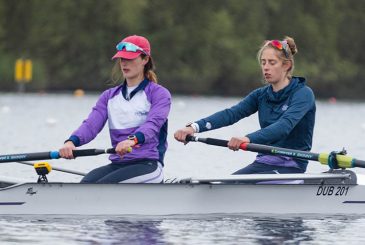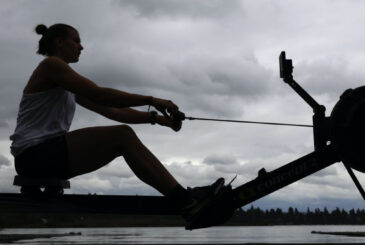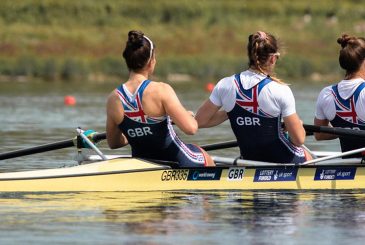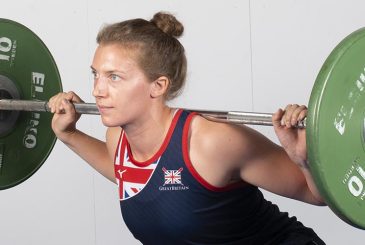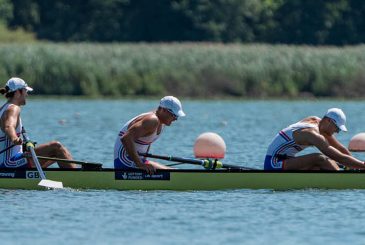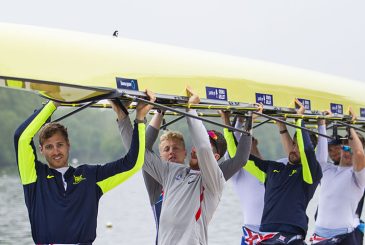Getting the right spread of intensity levels across your training is key to its effectiveness. In this second article in our series about elite training programmes, Dan Moore, Olympic High Performance Coach, introduces the GB Rowing Team seven-zone training matrix, explains how you can monitor intensity and explores why it’s important to train in each zone.
Training matrix
The GB Rowing Team (GBRT)’s training matrix, summarised in Table 1, describes each training intensity in terms of heart rate reserve, blood lactate level and Rate of Perceived Exertion (RPE). It can be used to prescribe the intensity that the coach wants a rower to train at but it also helps the rower to know if they are in the correct zone.
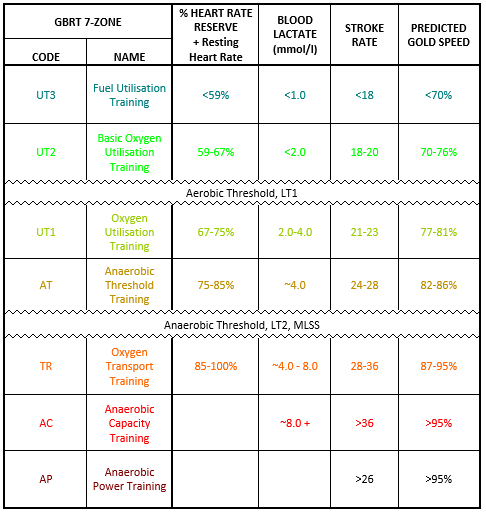
The GBRT uses blood lactate testing to measure training intensity; most club-based rowing programmes won’t have access to this, of course, but heart rate monitors are cheap and accessible and the (RPE) scale is also a surprisingly effective tool.
Why train in different zones?
Each zone is created to elicit physiological responses and, if done correctly, a successful training programme blends the zones together to develop both central and peripheral adaptations key to increasing endurance performance.
Although the GBRT matrix outlines seven zones, Dr Stephen Seiler, the exercise physiologist largely responsible for the emergence of the training intensity distribution (TID) field, has discussed that the various models of training intensity used in different sports are, in essence, based around three zones1. He suggests that these are what we should broadly consider when writing training plans because global physiological adaptations can be divided more basically in this way, and this helps the coach to analyse the amount of training completed in each area.
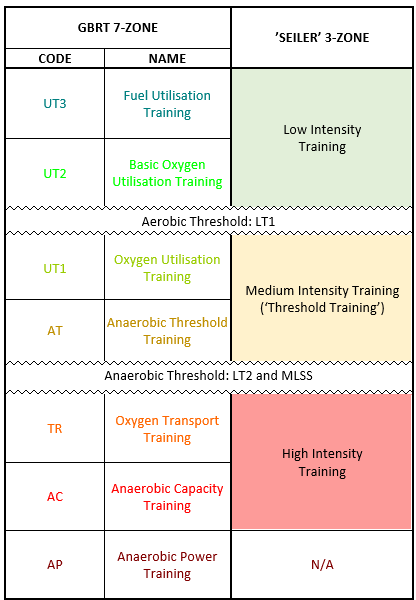
What do the three zones do?
Low intensity-training (LIT): training at or below the first lactate threshold, LT1 (less than approximately 2.0mmol.L-1) has traditionally been seen to stimulate peripheral adaptations, that is in or around the working muscle. It’s well-established that LIT increases mitochondrial density (mitochondria are the body’s aerobic power generators, producing energy within each cell). Therefore, over the long term, it is the best way to improve your body’s aerobic capacity, vital for elite rowing success2. An elite athlete can also use high levels of fat as a fuel source when training in this zone. This means that they can train, in theory at least, for hours on end.
Moderate-intensity-training (MIT): training between the first and second lactate thresholds, LT1-LT2 (approximately 2-4mmol.L-1) stimulates adaptations that are largely similar to those achieved during LIT but has the added benefit of improving anaerobic threshold efficiency by delaying the point at which the body goes from using mainly aerobic to mainly anaerobic energy. Typically, MIT will use almost entirely carbohydrate as a fuel source, limiting the amount of time a rower can spend in this zone. This limited time means it cannot stimulate the volume of peripheral adaptations possible during LIT.
High-intensity-training (HIT): training above the second threshold, LT2 (more than 4mmol.L-1) is associated with central adaptations such as improvement in VO2max through increasing cardiac stroke volume3 (the volume of blood pumped by each heart beat). HIT can also stimulate development of fast twitch muscle fibres (Type IIb) in ways that LIT and MIT struggle to achieve. Interestingly, HIT has also been found to increase mitochondria volume but given the short periods of time a rower can train at this intensity, it’s not an effective way to develop the aerobic capacity.
Adherence to training zones
Clearly, all three zones are important and therefore the skill in writing an effective elite training programme is in the balance of the three. In the next article in this series, we will explore the detail of how researchers have observed elite athletes training, but all you need to know now is that the overwhelming finding is a bias toward low intensity. The reason for this is recovery.
The main advantage of LIT is the small amount of time required to recover from it. Other than needing food, LIT has very little impact upon the body’s autonomic-nervous-system (ANS)4 and therefore an athlete can complete it in very large volumes.
While there is definite benefit in MIT, the main problem with it is that athletes often complete their LIT as MIT. I’m sure we can all think of the typical ‘push through it’ or ‘no pain, no gain’ type sessions! This means that they do too much MIT. The downsides of this include delayed recovery of the ANS, glycogen depletion, fatigue, and gastrointestinal disorders, all of which are associated with overtraining5 (or, more accurately, ‘overreaching’).
Finally, HIT has become increasingly popular over the last few years because it’s an effective way of getting fit quickly and is associated with improving VO2max. We all also know how important doing high intensity work is for preparing to race. However, the amount of recovery needed after these types of sessions is substantial. Therefore, unsurprisingly, studies that have investigated increasing the amount of HIT training have typically found no increase in performance and often indicators of over-training occur6.
Putting training zones into practice
The easiest way to balance these training zones across your plan is to start by identifying what day of the week you complete your high intensity pieces (for example if you do club ‘pieces’ on a Saturday). The next step is to factor in recovery and/or low intensity around this to allow the body to recover ready for the next bout on, say, Tuesday or Wednesday.
In the first article in this series we touched on the importance of super-compensation. This is the act of stressing the body above previous capacity and then recovering to adapt to a new level. You can be smart in how you adjust the intensity and/or recovery to make sure rowers experience overload, so long as you also factor in when they will be given time to adapt to the new load.
The next article in this series on designing elite rowing training programmes, discusses how elite athletes organise their training intensity – which is known as Training Intensity Distribution (TID) – to maximise performance.
References
- Seiler, Stephen and Tønnessen, Espen. (2009). Intervals, Thresholds, and Long Slow Distance: the Role of Intensity and Duration in Endurance Training. SPORTSCIENCE · sportsci.org. 13. 32-53. https://www.researchgate.net/publication/233855836_Intervals_Thresholds_and_Long_Slow_Distance_the_Role_of_Intensity_and_Duration_in_Endurance_Training, (Downloaded 9 January 2023)
- Treff, Gunnar, Winkert, Kay and Steinacker, Jürgen. (2021). Olympic Rowing – Maximum Capacity over 2000 Meters. Deutsche Zeitschrift für Sportmedizin/German Journal of Sports Medicine. 72. 203-211. 10.5960/dzsm.2021.485. https://www.researchgate.net/publication/352646755_Olympic_Rowing_-_Maximum_Capacity_over_2000_Meters (downloaded 9 January 2023)
- Bacon, Andrew, Carter, Rickey, Ogle, Eric and Joyner, Michael. (2013). VO2max Trainability and High Intensity Interval Training in Humans: A Meta-Analysis. PloS one. 8. e73182. 10.1371/journal.pone.0073182. https://www.researchgate.net/publication/257072506_VO2max_Trainability_and_High_Intensity_Interval_Training_in_Humans_A_Meta-Analysis (downloaded 9 January 2023)
- Seiler, Stephen, Haugen, Olav and Kuffel, Erin. (2007). Autonomic Recovery after Exercise in Trained Athletes. Medicine and science in sports and exercise. 39. 1366-73. 10.1249/mss.0b013e318060f17d. https://www.researchgate.net/publication/6078672_Autonomic_Recovery_after_Exercise_in_Trained_Athletes (downloaded 9 January 2023)
- Rosenblat, Michael, Perrotta, Andrew and Vicenzino, Bill. Polarized vs. Threshold Training Intensity Distribution on Endurance Sport Performance: A Systematic Review and Meta-Analysis of Randomized Controlled Trials. Journal of Strength and Conditioning Research 33(12):p 3491-3500, December 2019. | DOI: 10.1519/JSC.0000000000002618 https://journals.lww.com/nsca-jscr/fulltext/2019/12000/polarized_vs__threshold_training_intensity.34.aspx (downloaded 9 January 2023)
- Billat, Veronique, Fletchet, Bruno, Petit, Bernard, Muriaux, Gerard and Koralsztein, Jean-Pierre. Interval training at V˙O2max: effects on aerobic performance and overtraining markers. Medicine & Science in Sports & Exercise 31(1):p 156-163, January 1999. https://journals.lww.com/acsm-msse/Fulltext/1999/01000/Interval_training_at_V_O2max__effects_on_aerobic.24.aspx (downloaded 9 January 2023)



